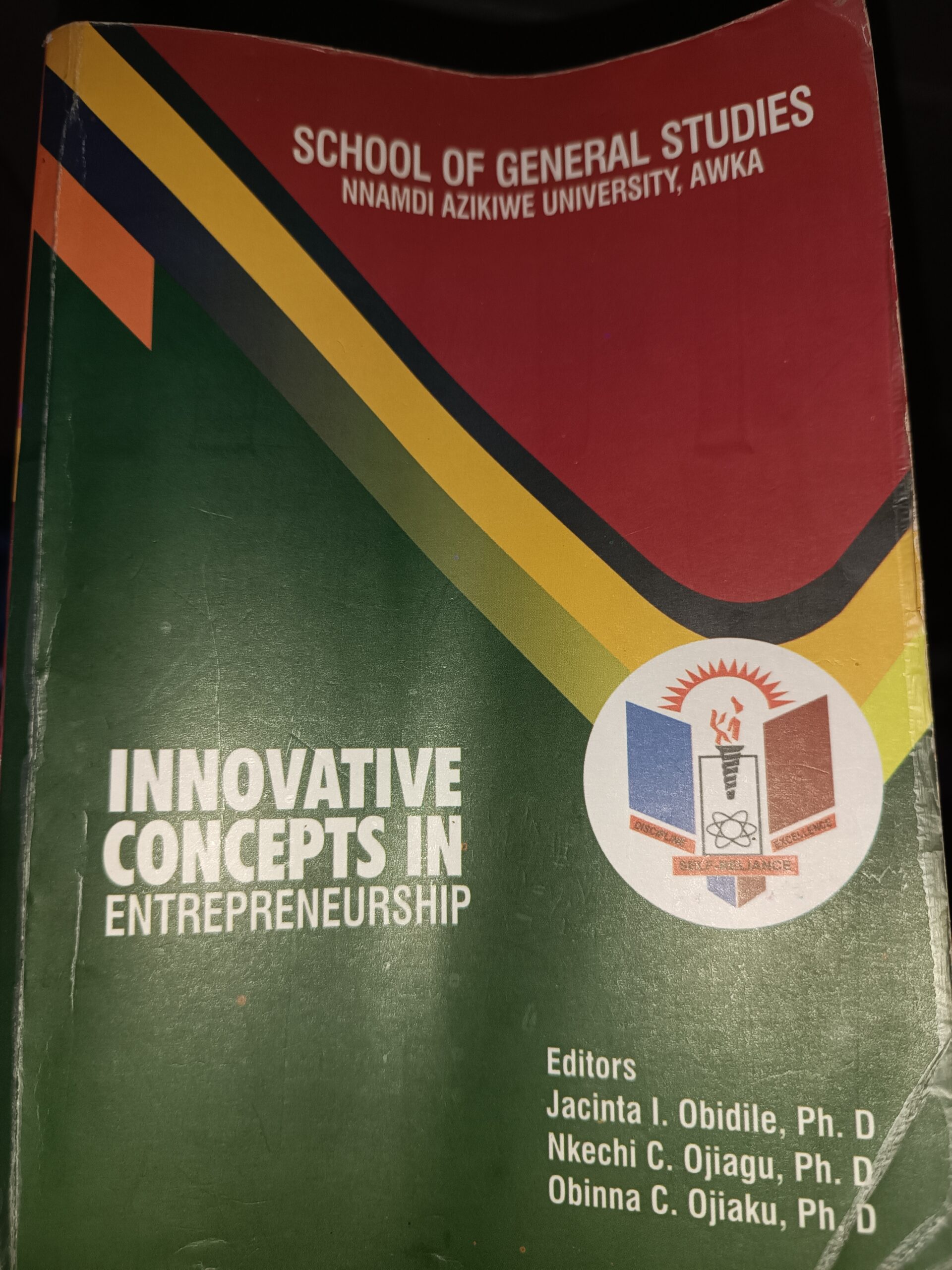CHAPTER ONE: INTRODUCTION
- Entrepreneurship is the purpose of designing, innovating, creating, launching and running a new business which offers a product, process or services for sale or lease.
- Hisrich and Brush (1985) defined entrepreneurship as a process of creating something different with value by giving in the necessary time and effort, tackling the social risks and receiving the resulting rewards of monetary, personal satisfaction and independence.
- Stoner, James and Freeman (1992) defined entrepreneurship as the seemingly discontinuous process of combining resources to produce goods and services
- Kilby (1971) defined entrepreneurship as the willingness and ability of an individual to seek out investment opportunities, establish and run an enterprise successfully.
- Entrepreneurship is an indispensable tool for economic development.
- Schumpeter (1934) defined an entrepreneur as any person who coordinates other factors of production and bears the risk of uncertainty by investing his scarce resources in the business as to make profit.
- Drucker (1964) defined an entrepreneur as a person who searches for change, responds to it and exploits the opportunity.
- Creativity and Innovation are vital tools of an entrepreneur
- Functions of an Entrepreneur include: Organizing, Risk-Taking, Decision Making, Conceptualizing New Opportunities and Possibilities, Technology Transfer, Implementation of Innovation, Utilization of Experience, Managerial Role, Co-ordination of Resources, Formation of Business, Creative.
- An Entrepreneur can coordinate his business indirectly (delegated authority)
- Characteristics of an Entrepreneur include: Motivation, Creativity and Persuasiveness, Versatility, Business Skill, Risk Tolerance, Drive and Energy, Vision, Flexibility, Decisiveness, Self-confidence, Money Management, Networking Ability, Leadership Ability, Long-term involvement.
- High Internal Locus of Control is when an entrepreneur believes in him/herself and not in fate.
- Sticking to financial management and discipline helps entrepreneurs to achieve goals and objectives in the business
- Classification of Entrepreneur
- Imitative Entrepreneurs: An entrepreneur that uses someone else business idea to start up his/her business.
- Solo Entrepreneurs: They are self-employed and operate alone.
- Team Entrepreneurs: Antithesis of solo entrepreneurs. They work in close-knit team
- Start-uppers: Entrepreneurs who contribute ideas that bring profit to the business.
- Challengers: These are Entrepreneurs who take risk in starting a new business.
- Inventors: Entrepreneurs with inventive ability, who design products and could develop, produce and sell items.
- Concept Multipliers: An entrepreneur who looks in someone else’s idea in other to create his/her business idea own based on the idea.
- Scales Exploiters: Entrepreneurs who benefit from large volume of sales by offering discount prices.
- Acquirers: Entrepreneurs who makes a business started by someone successful with his own idea.
- Buy-Sell Artists: They are innovators. Entrepreneurs who buy product for the purpose of re-selling it at a bigger profit.
- Internal Entrepreneurs (Intrapreneur): Entrepreneurs who create new ideas within an existing business.
- Franchisee: An individual who starts business for which a widely known product image has already been established.
- Necessity Entrepreneurs: Unemployed person who establish business to survive.
- Professionals: They are experts, highly specialized traditional professionals.
- Work Force Builder: An Entrepreneur who works on his own and builds a large company.
- Entrepreneur Involves identifying a new business opportunity, going into it and sustaining it.
- Intrapreneurship involves identifying an opportunity within an existing business, creating and obtaining a profitable venture from the opportunity.
- Difference between Entrepreneur and Intrapreneur
- An Entrepreneur owns the business and takes the risk, while an Intrapreneur is an employee of the company and doesn’t take risks.
- An Entrepreneur sacrifice in terms of financial loss while an Intrapreneur doesn’t because he is not the business owner.
- An Entrepreneur reaps the rewards while an Intrapreneur is paid salaries and allowances.
- An Entrepreneur is Independent, while an Intrapreneur depends on the entrepreneur, without the entrepreneur, Intrapreneur would not flourish.
- An Entrepreneur provides his own resource while an Intrapreneur depends on the company’s resource.
- An Entrepreneur makes the final decision while an Intrapreneur is under the control of the entrepreneur.
- Entrepreneurial Process is the step taken in order to perceive and utilize an opportunity maximally.
- Bygrave & Hofer (1989) defines entrepreneurial process as involving all the functions, activities and actions associated with the perceiving of opportunities and the creation of organization to pursue them
- Entrepreneurial Process Trend
Discover – Developing a Business Plan – Resourcing – Managing the company – Harvesting
- Models of Entrepreneurial Process Include:
- Carol Moore’s Descriptive model of entrepreneurial process (1986)
Innovation – Triggering Events – Implementation – Growth
- Jeffry Timmons Entrepreneur-Opportunity-Resources model of entrepreneurship process (1989): The success of business depends on three elements which are Opportunity, Resources and Team.
CHAPTER TWO THEORIES OF ENTREPRENEURSHIP
- Theories can be defined as links by which the experience of people are explained and understood.
- Theories of entrepreneurship include: Cultural Theories, Economic Theories, Sociological Theories and Psychological Theories.
- Cultural Theories are Cochran’s Theory of Cultural Values, Drucker’s Theory of Innovation (1909 -2005),ECO model and Hoselitz’s Social Cultural Theory.
- Economic Theories is the Knight’s Theory of Risk Taking (1885 – 1972)
- Sociological theories are Kunkel’s Behaviour-Elastic Theory, Cochran’s Environmental Theory, hagen’s Theory of Social Change.
- Psychological Theories are Need for Achievement Theory by McClelland, Schumpeter’s Theory of Aspiration to Power (1883 – 1950) and Weber’s Theory of Protestant Ethic and The spirit of Capitalism (1864 – 1920)
- Cultural Theories holds that the process of manipulating of human intelligence which manifest in creative behaviour, reflects the individual culture.
- The key proposition of Thomas Cochran’s Theory of cultural values is: cultural values, role expectations and social sanctions.
- According to Thomas Cochran the entrepreneur represents society’s model personality.
- Peter F. Drucker views an entrepreneur as one who searches for change, responds to it and exploits it as an opportunity.
- For Drucker, two things are important in the emergence of entrepreneurship – resource and innovation.
- Drucker asserts that the role of an entrepreneur includes: Increasing value through efficient utilization of resources, creating new values, creating value through innovation.
- The Kao’s model forms the basis for the ECO model. The ECO model is based on creativity, organization and entrepreneurship.
- According to Kao, an entrepreneurship is the platform for the exhibition of creativity acquired through the interaction of the person, the task and organizational components.
- Hoselitz assumes that individuals are endowed with cultural and social power.
- The Hoselitz’s Socio-Cultural Theory asserts that a society is only considered as developed and eligible for entrepreneurship on the basis of the culturally marginal people within it.
- The basis for Hoselitz theory are: Marginal men hypothesis, The importance of the managerial and leadership skills, Involvement of specific social classes
- The main advocates of Economist theory were Papanek and Harris.
- According to Papanek and Harris, economic incentives are the main focus for entrepreneurial activities in any country.
- Frank Knight views the innovative role of an entrepreneur in terms of profit making, uncertainty and risk taking.
- For Knight, uncertainty is defined as uninsurable risks in relation to events.
- Knight sees and entrepreneur as the business owner and residual claimant’s profits through his business activities.
- Features of the Knight’s Theory of Risk Taking are: Risk Creates Profit, More Risk More Gain, Profit as Rewards and Cost, Entrepreneur’s income is uncertain.
- Frank Knight’s theory of Risk Taking is a modification of Richard Cantillion’s (1680 – 1734) theory.
- According to Cantillion, entrepreneurship is connected to uncertainty and risks.
- John Kunkel Theory asserts that entrepreneurship is a function of the past, present and social structure milieu which is influenced by identifiable sociological factors such as reward and punishment syndrome.
- For John Kunkel, the factor of reward and punishment are prominent in the act of entreprenuership.
- Thomas Cochran holds that environment in which an individual was brought up determines his urge for entrepreneurship.
- The Cochran’s Environment Theory perceives that the entrepreneur is the representative of his society’s personality model.
- In the Cochran’s Theory, social values and norms are determinant factors of the individual attitude towards business and societal expectations.
- Hagen’s Theory of Social Change presumes entrepreneurial creativity as a key element that exhorts social transformation and economic growth.
- For Hagen, economic development is a phenomenon brought about by creativity and technological innovation of entrepreneurs.
- The Need for Achievement Theory by McClelland posits that people exhibit this high need for achievement have a high probability of succeeding in businesses.
- The Need for Achievement Theory is and extension of Weber’s theory of protestant ethic.
- According to McClelland the characteristics of entrepreneur has two feature- Doing things in a new and better way, Decision making under uncertainty.
- According to McClelland, N-Ach is a relatively stable personality characteristics rooted in experiences in middle childhood through family socialization and child-learning practices which stress standards of excellence, material warmth, self-reliance training and low father dominance.
- McClelland indicated 5 major components to the N-ach trait a) Responsibility for problem solving (b) Setting goals (c) Reaching goals through one’s own effort (d) the need for and use of feedback (e) A preference for moderate levels of risk-taking.
- Schumpeter’s Theory identifies entrepreneur as a separate factor other than land, labour and capital.
- For Schumpeter, an entrepreneur must be futuristic with high degree of accurate forecasting ability if he must succeed.
- According to Weber Religion some religions have basic beliefs to earn and acquire money and some have less of it. This he called “spirit of capitalism” and “adventurous spirit”
- Weber states the entrepreneurial culture is shaped by religious belief.
- He emphasized that entrepreneurial forces apart from innovation, are externally supplied by religious beliefs.
44.Weber emphasized on the following: Spirit of Capitalism, Adventurous Spirit, Protestant Ethics
CHAPTER THREE ESTABLISHING A NEW BUSINESS
- Business ideas could emanate from perceptions, market and consumers need analyses, events, market trends, exhibitions and trade fairs.
- Thompson (2003b) defined a business plan as a road map which is used to help an entrepreneur chart his progress by outlining the things he needs to do in order to reach his goals.
- A feasible study is defined as a controlled process for identifying problems and opportunities, determining objectives, describing situations, defining successful outcomes and assessing the range of costs and benefits associated with several alternatives for solving a problem.
- Contents of a Feasibility Study are: The (business) concept section, The Market Section, Operational Information, The Financial Section, Funding requirements.
- Different Sources of Finance include: Personal Savings, Capital Borrowed from Relatives and Friends, Venture Capital, Bank Loans, Loans from co-operative societies and grants and subsidies from government programmes.
- Issues of Concern in Business include: Business Name, Business Structure, Business Licenses, Intellectual Property, and insurance.
- Insurance is an agreement where, for a stipulated payment called the “premium”, one party (the insurer) agrees to pay to the other (the policyholder or his designated beneficiary) a defined amount (the claim payment or benefit) upon the occurrence of a specific loss.
CHAPTER FOUR ENTREPRENEURSHIP AND MANAGEMENT
- Entrepreneurship is the catalyst for economic growth.
- Entrepreneurship is the willingness and ability of an individual to identify and successfully carryout investment opportunities in an environment (Kayode,2006)
- benefits of Entrepreneurial Activities are: Increasing Productivity, Creating new technologies, products and/or services, Enhancing Economic growth, Fostering Market Competition
- According to Zoltan (1992), small businesses created by entrepreneurs are agents of change in a market economy.
- Entrepreneurship Barriers as listed by “Vesper” includes: lack of viable concept, Lack of Market Familiarity, Lack of Technical skills, Lack of seed capital, lack of Business Know-how, No motivation, Social stigma, Job Lock-In, Time pressures, Legal constraints, Patent inhibitions, Protectionism and Monopoly.
- The Psychological Factors of Entrepreneurship were stipulated by “David McClelland” in the early 1960s which are: Need- achievement, Locus of Control, Type A behaviour, Tolerance of ambiguity, Tolerance for risk.
- According to Ellen Fagerson, entrepreneurs tend to value self- respect, freedom, a sense of accomplishment and an exciting lifestyle, while Managers tend to value friendship, wisdom, salvation, pleasure, among others.
- Sociological factors affecting entrepreneurship is that often members of minority groups feel that employers discriminate against them either directly or indirectly.
- Management is the process of working with and through others to achieve organizational objectives in a dynamic environment.
- Management involves and concentrates on reaching organizational goals.
- The basic task of management includes both marketing and innovation.
- Herri Fayol, a French industrialist, became the father of functional approach in 1916.
- The major functions of Management include: Planning, Organizing, Staffing, Leading and controlling.
- Structural Considerations such as chain of command, division of labour and assignment of responsibility are part of organizational function.
- Steps in Organizing include:
- Identification and classification of required activities.
- Grouping of activities
- Assigning each group to a manager for supervision
16. The process of staffing are: Manpower planning, Recruitment, Selection, Placement and orientation, Training, Development, Promotion. Transfer, Appraisal, Remuneration.
- Leading is the use of influence to motivate employees to achieve organizational goals.
- Three components that make up the leading function as adapted from Hartzell are: Motivating employees, Influencing employees, forming effective groups.
- Three basic components of controlling function are:
- Elements of a control system
- Evaluating and rewarding employee performance
- Controlling financial, information and physical resources
20. Wilken (2009) stated that entrepreneurship involves initiating changes in production, whereas management involves the ongoing coordinating in the production process.
- Successful managers are the ones who anticipate and adjust to changing circumstance.
- Sources of change in management include: Globalization, Evolution of product quality, Environmentalism, Ethical Reawaken, Internet revolution.
- Mouzas(2006) emphasizes two indicators to assess performance which are: the efficiency and the effectiveness.
- Efficiency is the ability to minimize the use of resources in achieving organizational objectives doing things right and effectiveness is the ability to determine appropriate objectives doing the right thing.
- Chain of Effects between efficiency and effectiveness Efficiency
- Effectiveness oriented companies are concerned with output, sales, quality, creation of value added, innovation and cost reduction.
- Meyer and Herscovitch (2011) analysed organizational effectiveness through organizational commitment.
- According to Kennedy-Philips (20110 organizational effectiveness helps to access the progress towards mission fulfilment and goal achievement.
- Efficiency measures the relationship between inputs and outputs.
- Pinprayeng and Siengthia (2012) introduced seven dimensions for the measurement of management efficiency which are: Organizational Strategy, Coporate structure design, Management and business system building, Development of corporate and employee styles, Motivation of staff commitment, Development of employee’s skills, subordinate goals.
- Return of Assets (ROA) is a suitable measure of overall company performance.
- Organization performance = Effectiveness × Efficiency
- High effective and high efficient organizations are well known as high performance entities.
CHAPTER FIVE FINANCIAL AND RECORDS MANAGEMENT
- Finance is the lifeblood of business organization.
- Ordu (2013) opined that entrepreneurs need financial management skills to enable them monitor and disseminate proper financial information for the survival of their businesses.
- Paramasivan and Subramanian (2012) defined financial management as an essential part of the economic and non-economic activities which help to decide the efficient procurement and utilization of finance in a profitable manner.
- Financial management encompasses all activities involved in effective conversion and utilization of business fund.
- International Organization for standardization IOS (2001) defines Records Management (RM) as the field of management responsible for the efficient and systematic control of the creation, receipt, maintenance, use and disposition of records, including the processes for capturing and maintaining evidence of information about business activities and transactions in the form of records.
- Record is a document that represents proof of existence.
- An Entrepreneur has two basic types of records to maintain for his They are: i. Financial records and accounts ii. Activity Records.
- Financial Records relate primarily to the income and expenditure of the business.
- The accounts of an enterprise include: Income statement (Profit or Loss Account), Statement of Financial Position, Cash Flow statement.
- Activity Records are the production records for a business that generates output from within, rather than the option of external purchase of outputs for resale.
- Benefits of Records Management include: Compliance with regulations, Business decision making, Performance monitoring.
- The choice of record management could be either manual or electronic.
CHAPTER SIX BUSINESS THREAT
- Periodic Analysis is should be conducted to overcome threats in a business environment.
- Core competencies are capabilities that could help the business to achieve competitive advantage.
- SWOT – Strength, Weakness, Opportunity and Threat.
- SWOT is one of toots used in business analysis.
- SWOT strategy was adapted from Gratis (2017)
- Benefits of SWOT are:
- Simple to do and practical to use
- Clear to Understand
- Focuses on the key internal and external factors affecting the company.
- Helps to identify future goals
- Initiates further analysis
CHAPTER SEVEN INFORMATION AND COMMUNICATION TECHNOLOGY (ICT) AND ENTREPRENEURSHIP
- ICT is generally accepted to mean all devices, networking components, applications and systems which combine, allow people and organization to interact in the digital world.
- The term ICT also refers to the convergence of audio-visual and telephone network with computer networks through a single cabling or link system.
- ICT encompasses both the internet and intranet enabled devices.
- A computer network is a group of computers connected to each other electronically.
- The components of a computer network include: a computer, the router, the gateway, the bridge networking device, the switch for networking and the hub.
- ICT resources in business include: The computer system, internet, Intranets and Extranets, Electronic mail (E-mail), mobile phone and fax machine.
- A computer is a programmable electronic device designed to accept data, perform prescribed mathematical and logical operations and displays result of these operations.
- Intranet is an internal or private network of an organization based on internet technology (such as hypertext and TCP/IP protocols) and accessed over the internet.
- Intranet is exclusively for the use of the organization and its association.
- Intranets primary objective is to facilitate internal communication.
- Extranet is a private network designed to allow outside individuals from other organizations communicate with the members of the organization.
- Electronic mail (e-mail) is the transmission of information via communication networks such as the internet.
- Mobile Phones are electronic transmission that is connected to a wireless communication network through radio wave or satellite
- Fax Machine is a “telefacsmile system” that replicates original documents by scanning a single fixed graphic image, converting it into bitmap and transmitting it through the telephone system in the form of audio-frequency tones.
- Webster (2017) defined technology as the practical application of knowledge in a particular area in a manner of accomplishing a task especially using technical processes, methods or knowledge.
- Technology in enterprise refers to the manner of application of knowledge for business operations to achieve objectives.
- The e-business (Electronic Business) is the application of electronic network technology including internet and electronic data interchange (EDI) to improve and change business processes.
- Processes involved in e-business are: Production processes, Customer services, Internal Management processes.
- The e-entrepreneurship refers to establishing a new company with an innovative business idea within the net economy.
- Functions of ICT include: Gathering and Recording of Data, Data Generation of Information, Storage of Information, Retrieval of Information.
- Benefits of ICT in Business are Quick and Better Decision-Making, Improved Communication, Research and Development, Increased Productivity, Improved Customer Service, Greater Collaboration, Improved Financial Performance, Web Based Advertising, Proper Storage of Records and Information.
CHAPTER EIGHT MARKETING AND ENTREPRENEURSHIP
- Peter Drucker, the father of management identified marketing as one of the core functions of the business.
- Kotler and Amstrong (2010) defined marketing as the social and managerial process by which individual and organizations obtain what they need and want through creating and exchanging value with other.
- Marketing Functions consist of: Merchandizing, Buying and Selling, Standardization and Grading, Storage and Transportation, Marketing Finance, Risk Bearing and Marketing Information and research.
- Marketing Concept are philosophies used by entrepreneurs to guide their marketing efforts.
- Marketing Concepts is also known as Marketing Management philosophies.
- There are six marketing concepts which are: Production concept, Product concept, Selling concept, Marketing concept, Social Marketing concept and Holistic Marketing concepts.
- The view point of Product concept was encapsulated in Says Law.
- Says law states that supply creates its own demand.
- An entrepreneur market can broadly be classifies into consumer market and industrial Market
- Consumer market consist of all individual who buy goods and services for personal or domestic consumption.
- Industrial markets is also known as business markets
- Industrial market are organizations that buy goods and services for further production of other goods/ services or for resale.
- Industrial markets consist of producers, marketing intermediaries, institutions and governemts.
- Industrial markets are usually characterized by derived demand, a huge market with few buyers and close buyer-seller interactions.
- Marketing Research is the systematic and objective means of collecting, analysing and interpreting data relevant for making informed marketing decision.
- Entrepreneurs conduct marketing research to obtain information.
- According to Kotler (1980), Marketing plan is a written document that spells out the goods, strategies and tactics that will be used to gain and maintain the competitive position and results that the firm is seeking.
- Marketing plan differs from marketing planning because marketing planning is a continuous process and function and is never completed while marketing plan has a time frame.
- Content of the Marketing Plan include: Executive summary, Situation analysis, Objectives and goals, Strategy statement, Action programs, Budgets and control.
- There are six types of Marketing Plan: Brand Marketing plans, New Product plans, Geographical marketing plans, Product category marketing plans, Market segment plans, Customer plans.
- Marketing problems facing Entrepreneurs are: Competition, Lack of Marketing and Selling skills, Promotion and Advertising cost, Understanding what customers want, Finding the Right Distribution channel.
- Consumerism is the organized movement of consumers/ customers and government aimed at aiding and protecting the rights, interests and powers of consumers/customers by exerting legal, moral and economic pressure on business Kotler (2010)
- The protection of the consumer’s right is the key focus of
- Components of Consumerism include: Self-protection by consumer and Regulation of business through legislation.
- The first formal declaration of consumer’s right protection came in 1962 by President John Kennedy.
- They are eight consumers’ right: Right to safe products, Right to be informed about relevant aspect of a product, right to be heard, Right to choose what to buy, Right to be educated about purchase, Right to basic needs, Right to presentation, Right to good environment.



